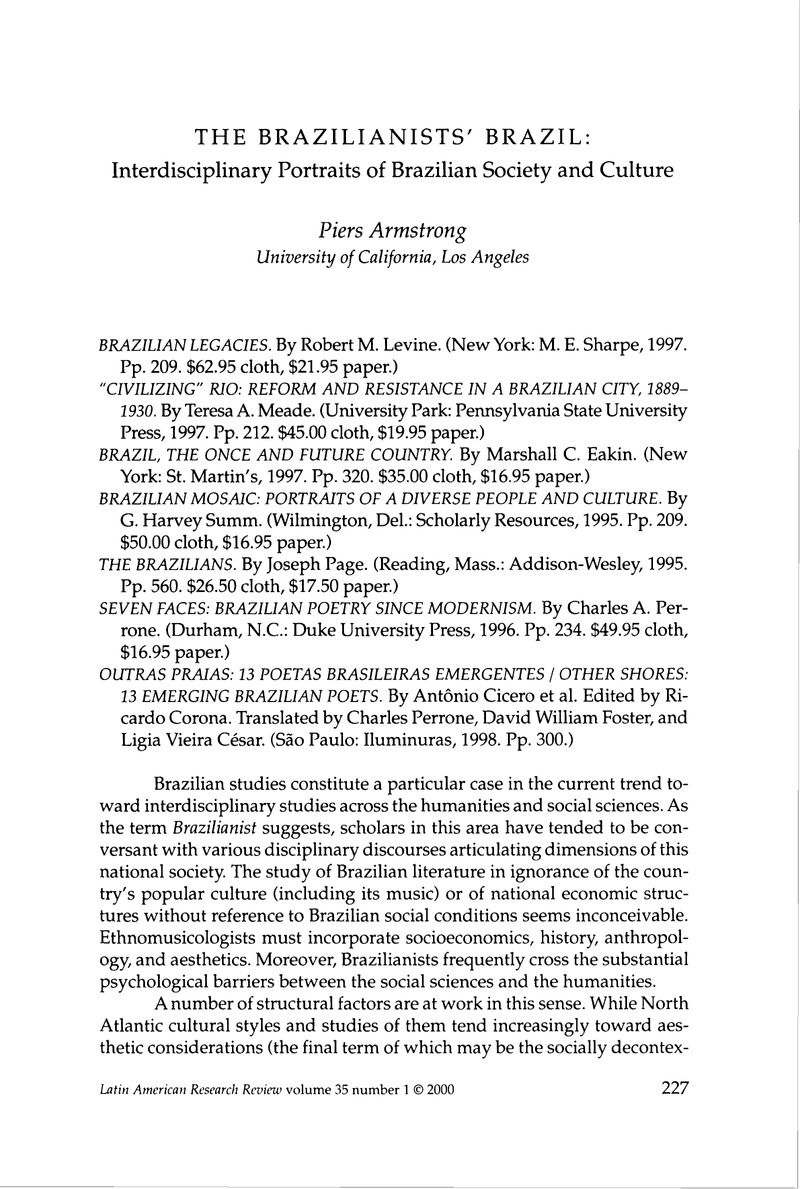Published online by Cambridge University Press: 05 October 2022

1. Paulo Prado, Retrato do Brasil: Ensaio sobre a tristeza brasileira (Rio de Janeiro: Briguiet, 1931); Sérgio Buarque de Holanda, Raízes do Brasil (Rio de Janeiro: José Olympio, 1936); and Gilberto Freyre, Casa grande e senzala (Rio: Maia e Schmidt, 1933).
2. See for example Donald Pierson's Negroes in Brazil: A Study of Race Contact at Bahia (Chicago, Ill.: University of Chicago Press, 1942); or Marvin Harris's Patterns of Race in the Americas (New York: Norton, 1964).
3. Daphne Patai, Brazilian Women Speak: Contemporary Life Stories (New Brunswick, N.J.: Rutgers University Press, 1988); Nancy Scheper-Hughes, Death without Weeping: The Violence of Everyday Life in Brazil (Berkeley and Los Angeles: University of California Press, 1992); Alma Guillermoprieto, Samba (New York: Knopf, 1990); Candace Slater, Dance of the Dolphin: Transformation and Disenchantment in the Amazonian Imagination (Chicago, Ill.: University of Chicago Press, 1994); Slater, Stories on a String: The Brazilian Literatura de Cordel (Berkeley and Los Angeles: University of California Press, 1982); and Rowan Ireland, Kingdoms Come: Religion and Politics in Brazil (Pittsburgh, Pa.: University of Pittsburgh Press, 1991).
4. For example, Bradford Burns's A History of Brazil uses the Canudos episode in this way.
5. See Levine's substantial mapping of scholarship: Brazil, 1822–1930: An Annotated Bibliography for Social Historians (New York: Garland, 1983); Brazil since 1930: An Annotated Bibliography for Social Historians (New York: Garland, 1980); and Historical Dictionary of Brazil (Metuchen, N.J.: Scarecrow, 1979).
6. Levine supervised the re-edition of the texts by Carolina Maria de Jesus that had been translated into English. After the successful 1962 release by Dutton of her original diary-book Child of the Dark (Quarto de despejo), her texts became unavailable. Through Levine's efforts, in the last three years, English translations have appeared as I'm Going to Have a Little House: The Second Diary of Carolina Maria de Jesus (Lincoln: University of Nebraska Press, 1997) and Bitita's Diary: The Childhood Memoirs of Carolina Maria de Jesus (New York: M. E. Sharpe, 1998). See also The Life and Death of Carolina Maria de Jesus, edited by Robert M. Levine and Jose Carlos Sebe Bom Meihy (Albuquerque: University of New Mexico Press, 1995). Levine has also written a major study on Canudos, Vale of Tears: Revisiting the Canudos Massacre in Northeastern Brazil (Berkeley and Los Angeles: University of California Press, 1992).
7. Another interdisciplinary survey recently released is the substantial tome entitled Brazil: A Country Study, edited by Rex A. Hudson (Washington, D.C.: Federal Research Division, Library of Congress, 1998). The volume features survey essays on history, economics, politics, and other areas ranging from fifty to eighty pages each.
8. Another notable recent bilingual anthology is Nothing the Sun Could Not Explain (Los Angeles, Calif.: Sun and Moon, 1996), a more eclectic collection reflecting its original inspiration through U.S. initiatives. Outras praias was also partly an outgrowth of interest in Brazilian poetry from the same U.S. source, the post-Beat poetry scene on the West Coast (particularly Lawrence Ferlinghetti). These two works enrich the limited collection of bilingual anthologies in Brazilian Portuguese and English. Among these remains the classic volume edited by famous U.S. poet Elizabeth Bishop with Emanuel Brasil, An Anthology of Twentieth-Century Brazilian Poetry. Released by Wesleyan University Press in 1972, the book is currently available in paperback from the University of New England Press.